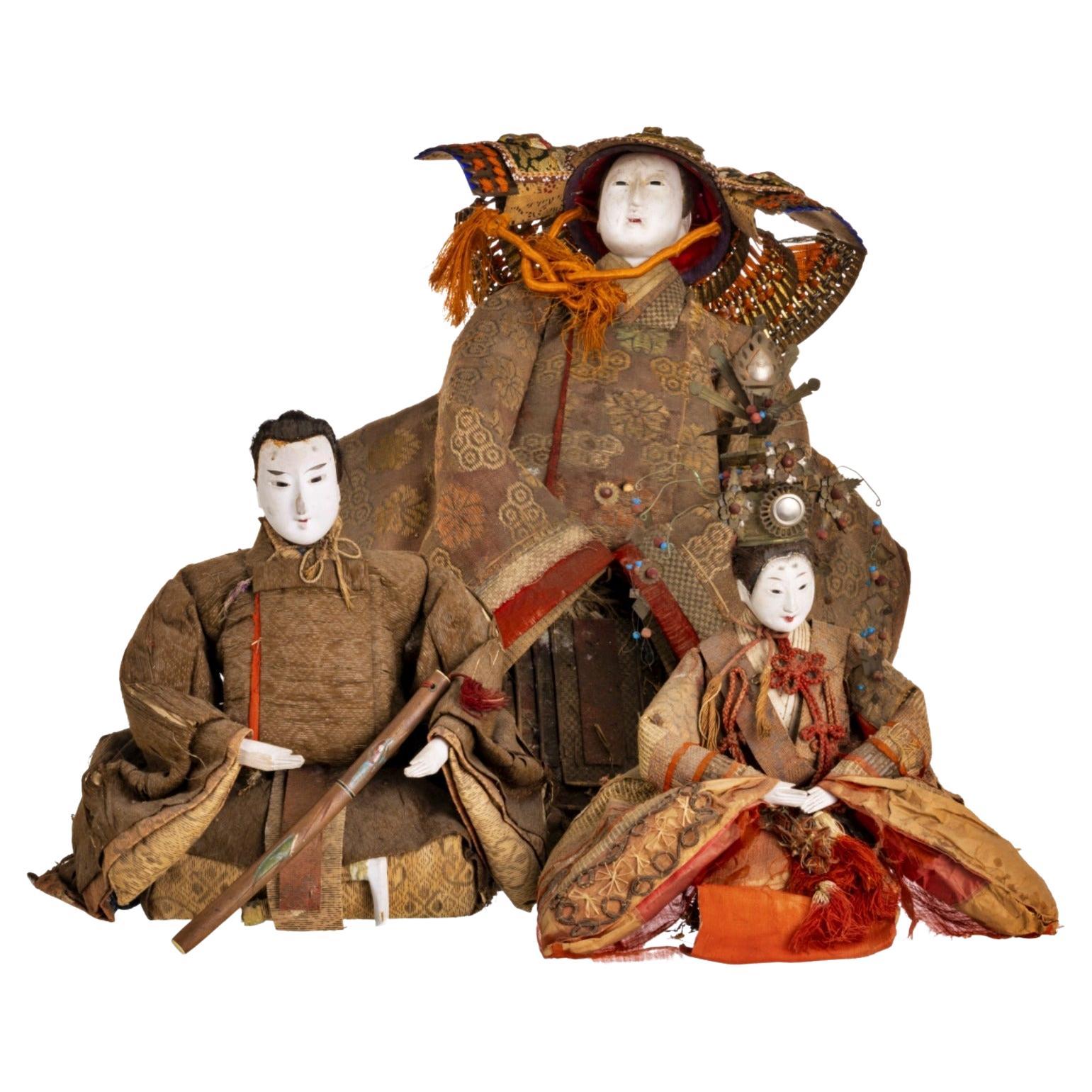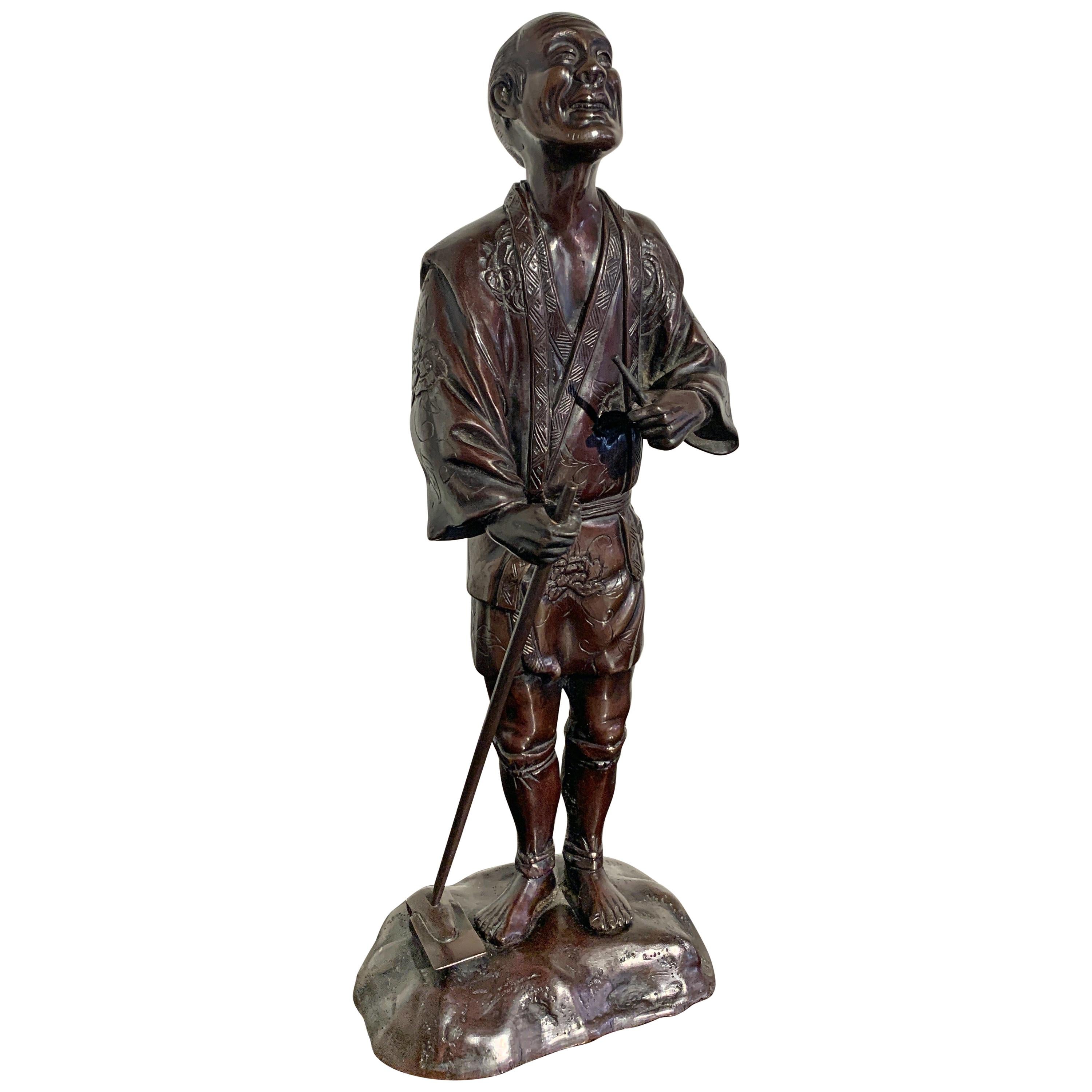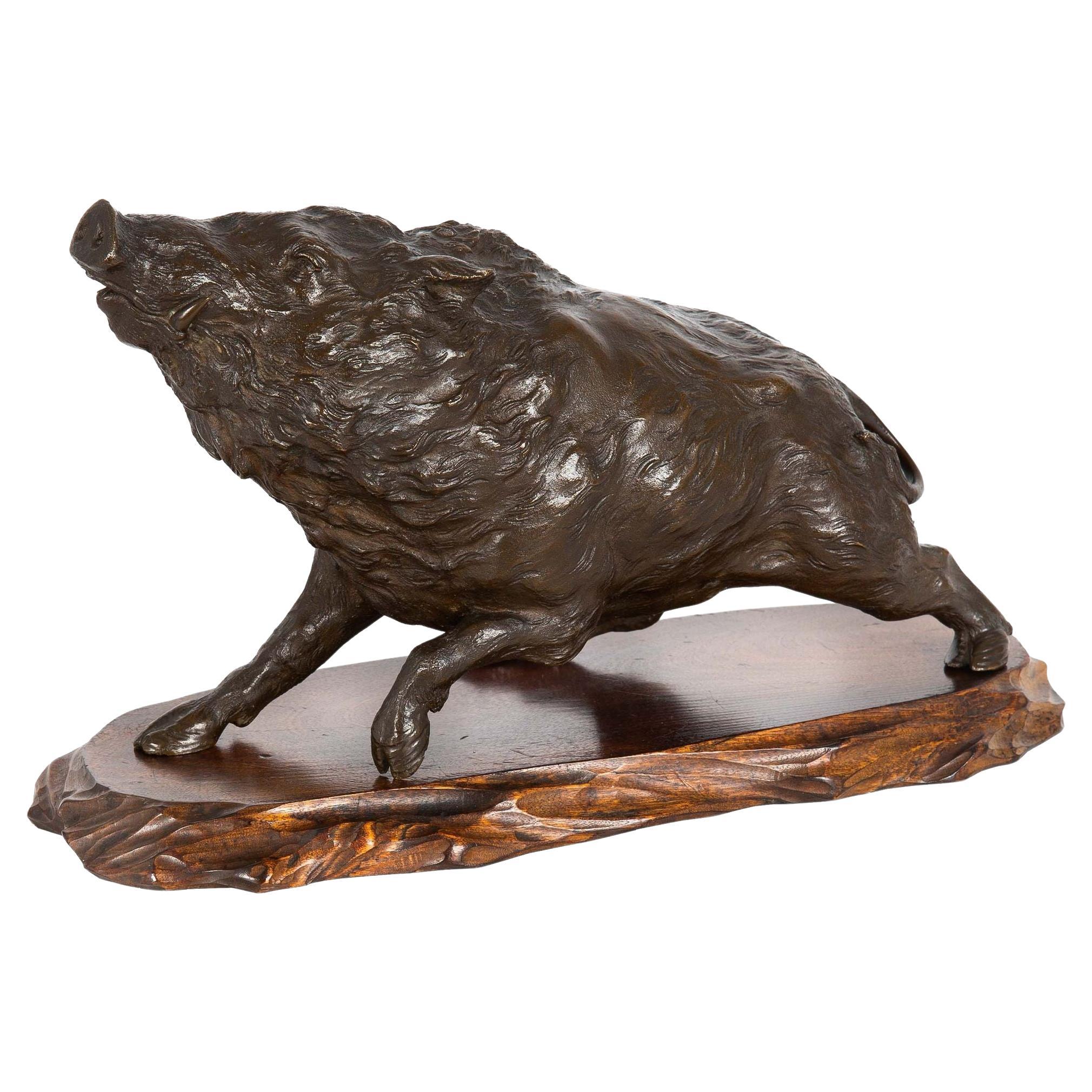Items Similar to Japanese Meiji Period (1868-1912) Bronze Monkey Group Okimono by Shosai
Want more images or videos?
Request additional images or videos from the seller
1 of 18
Japanese Meiji Period (1868-1912) Bronze Monkey Group Okimono by Shosai
About the Item
Featuring Seven Japanese Macaques Cast by Shosai 正齊鋳
Form our Japanese collection, we are delighted to offer this Japanese Bronze Monkey Group Okimono. The Japanese Monkey Group formed as a male father monkey and his infants playing around and being mischievous with Persimmon fruit. The monkeys modelled as Japanese macaque monkeys (snow monkey). The bronze beautifully patinated with a highly lifelike and naturalistic casting signed to the underside Shosai 正齊鋳. The Bronze group dates to the Meiji Period (1868-1912) circa 1880.
Japanese macaque (snow monkey) is a terrestrial Old World monkey species that is native to Japan. They are known as snow monkeys because some live in areas where snow covers the ground for long periods each year hence their nickname. No other non-human primate lives further north or in a colder climate than the snow monkey. Individuals have brownish grey fur, pinkish-red faces, and short tails. Two subspecies are known and their conservation Status is of least concern. In Japan, the species is known as Nihonzaru ニホンザル, 日本 (Japan/Nihon) and saru 猿 (monkey) to distinguish it from other primates, but the Japanese macaque is the only species of monkey in Japan.
The Japanese macaque features heavily in the religion, folklore, and art of Japan, as well as in proverbs and idiomatic expressions in the Japanese language. They are often seen in paintings, block prints and represented in all manner of carvings from Okimono to netsuke. Many of these art forms reside in the world’s most famous museums and collections, some of the most prominent pieces by artists such as Mori Sosen and Kawanabe Kyosai. In Shinto belief (Japan’s indigenous religion/nature religion) legendary mythical beasts known as raiju sometimes appeared as monkeys and kept Raijin (the god of lightning/storms) company. In another well known tale the three wise monkeys who warn people to “see no evil, hear no evil and speak no evil” can be seen depicted in relief over the door of the famous Tosho-gu shrine in Nikko.
Meiji Period was an era of Japanese history that spanned from 1868 to 1912. It was the first half of the Empire of Japan, when the Japanese people began to build a paradigm of a modern, industrialised nation state and emergent great power, influenced by Western countries and aesthetics. As a result of radically different ideas, the changes to Japan were profound and it affected the social structure, politics, economy, military, and foreign relations across the board. The period corresponded to the reign of Emperor Meiji and was preceded by the Keio era and was succeeded by the Taisho era.
Cultural Art during the Meiji Period was of particular interest to the government and they overhauled the art export market which in turn promoted Japanese arts via various world’s fairs, beginning in Vienna at the world fair in 1873. The government heavily funded the fairs and took an active role organising how Japan’s culture was presented to the world including creating a semi-public company named Kiritsu Kosho Kaisha (First Industrial Manufacturing Company). The Kiritsu Kosho Kaisha was used to promote and commercialise exports of Japanese art and established the Hakurankai Jimukyoku (Exhibition Bureau) to maintain quality standards. For the 1876 Centennial International Exhibition in Philadelphia, the Japanese government created a Centennial Office and sent a special envoy to secure space for the 30,000 items that would be displayed. The Imperial Household also took an active interest in arts and crafts, commissioning works by select artists to be given as gifts for foreign dignitaries further emphasising the high quality and importance of Japanese art. Just before the end of the 19th century in 1890, the Teishitsu Gigeiin (Artist to the Imperial Household) system was created to recognise distinguished artists. These artists were selected for their exceptionally high quality wares and talent in their own industry. Over a period of 54 years Seventy artists were appointed, amongst these were ceramicist Makuzu Kozan and cloisonné enamel artist Namikawa Yasuyuki.
Bronze an alloy consisting primarily of copper with approximately 12–12.5% tin and often with the addition of other metals (including aluminium, manganese, nickel, or zinc) and sometimes non-metals, such as phosphorus, or metalloids such as arsenic or silicon depending on the age of the bronze and its origin. The additions of other metals produce a range of alloys that are usually harder than copper alone and carry useful properties such as strength. The earliest known use of bronze dates to the 5th millennium BCE from Iranian plateau, the bronze mix consists of arsenical copper and copper-arsenide. The earliest tin-copper-alloy recovered is dated to circa 4650 BCE and was found in Plocnik, Serbia. It is believed to have been smelted from a natural tin-copper ore.
Measurements (Centimetres) 18cm Wide x 16cm Deep x 13cm High
- Dimensions:Height: 5.1 in (12.96 cm)Width: 7 in (17.78 cm)Depth: 6.3 in (16.01 cm)
- Style:Meiji (Of the Period)
- Materials and Techniques:Bronze,Cast
- Place of Origin:
- Period:
- Date of Manufacture:Circa 1880
- Condition:Wear consistent with age and use.
- Seller Location:Newark, GB
- Reference Number:Seller: KADDS1stDibs: LU6971238067842
About the Seller
5.0
Vetted Seller
These experienced sellers undergo a comprehensive evaluation by our team of in-house experts.
Established in 2019
1stDibs seller since 2022
18 sales on 1stDibs
Typical response time: 3 hours
- ShippingRetrieving quote...Ships From: Newark, United Kingdom
- Return PolicyA return for this item may be initiated within 14 days of delivery.
More From This SellerView All
- Japanese Meiji Period (1868-1912) Three Wise Monkeys Box Komyo 光明Located in Newark, EnglandThe Silver box of rectangular form with rounded corners features the Three Wise Monkeys to the front, see no evil, hear no evil and speak no evil. The monkeys cast beautifully with n...Category
Early 20th Century Japanese Meiji Metalwork
MaterialsSilver, Enamel
- Japanese Meiji Period Bronze Group Bear & Alligator by YoshimitsuLocated in Newark, EnglandThe Japanese group comprises of a Bear being attacked by a large alligator. The alligator jumping on the back of the Bear with mouth wide opening showing its razor sharp teeth. The b...Category
Antique Late 19th Century Japanese Meiji Animal Sculptures
MaterialsBronze
- Japanese Meiji Period (1868-1912) Silver Dragon BoxLocated in Newark, EnglandHammered Silver Decoration Stamped Jungin Pure Silver 純銀 From our Japanese collection, we are pleased to offer a Japanese Meiji Period Silver Dragon Box...Category
Antique Late 19th Century Japanese Meiji Metalwork
MaterialsSilver
- Japanese Meiji Period Carved Wood Okimono Man with RabbitsLocated in Newark, EnglandThe charming figure, carved from a single piece of wood is exceptionally carved showing the male figure with humorous expression holding two Rabbits one by the ears and the second under his arm. A third Rabbit stands at the feet of the male looking up, each rabbit with a different expression. The male figure is wearing traditional Japanese attire with his hair tied back stood upon a naturalistic base. The figure dates to the Meiji Period (1868-1912) circa 1900. Notes The Rabbit is one of the 12 animals to feature in the Japanese Zodiac signs which follows the Chinese astrological system along with the Rat, Ox, Tiger, Rabbit, Dragon, Snake, Horse, Goat, Monkey, Rooster, Dog, Pig. Such division is connected with the Jupiter cycle around the Sun, which lasts about 12 years. As 2023 is the year of the Rabbit...Category
Antique Early 1900s Japanese Meiji Sculptures and Carvings
MaterialsWood
- Japanese Bronze Vase Pair Meiji PeriodLocated in Newark, EnglandA fine large sized pair of Japanese bronze vases. The vases each surmounted by waisted necks flanked by two spreading handles with accents in the form of Japanese Torri (traditional ...Category
Antique Late 19th Century Japanese Meiji Metalwork
MaterialsMetal, Gold, Silver, Bronze, Copper
- Japanese Meiji Period Koi Carp Bronze BoxLocated in Newark, EnglandJapanese meiji period mixed metal box. The box formed in a kidney shape decorated with swimming koi carp fish throughout. Each koi with intricate detailing wi...Category
Antique Early 1900s Japanese Meiji Metalwork
MaterialsMetal, Gold, Bronze
You May Also Like
- THREE FIGURES HINA MATSURI Japanese, Meiji period (1868-1912)By Europa AntiquesLocated in Madrid, ESTHREE FIGURES HINA MATSURI Japanese, Meiji period (1868-1912) in painted plaster, eggshell, silk and other materials. Height: (largest) 50 cm good condit...Category
Antique 19th Century Japanese Japonisme Figurative Sculptures
MaterialsSilk, Plaster
- Japanese Tokyo School Bronze Okimono of a Farmer, Meiji PeriodLocated in Austin, TXA very fine and detailed Tokyo School cast bronze okimono (decorative sculpture) of a smiling farmer, Meiji period, late 19th century, Japan. The e...Category
Antique Late 19th Century Japanese Meiji Sculptures and Carvings
MaterialsBronze
- Japanese Meiji Period Carved Large Turtle OkimonoLocated in New York, NYA Japanese Meiji Period late 19th, early 20th century carved boxwood turtle okimonoCategory
20th Century Japanese Sculptures
MaterialsBoxwood
- Japanese Meiji Bronze Okimono of a Wild Boar by Akasofu GyokkoLocated in Shippensburg, PAOKIMONO OF A WILD BOAR Japan, Meiji Period Patinated bronze over carved hardwood base Signed "Gyokko" to underside of boar Item # 301COR20S This remarkable sculpture was designe...Category
Antique 19th Century Japanese Meiji Animal Sculptures
MaterialsBronze
- Fine Japanese Meiji Bronze Okimono Sculpture of Tiger by MitaniLocated in Shippensburg, PAOKIMONO OF A ROARING TIGER OVER A WOODEN BASE Japan, Meiji Period Patinated bronze signed Mitani to underside of belly Item # 302LOC16P This remarkable Japanese bronze okimono o...Category
Antique 19th Century Japanese Meiji Animal Sculptures
MaterialsBronze
- Japanese Meiji Period Bronze Okimono Sculpture of a Roaring Tiger, 27” wideLocated in Shippensburg, PAMEIJI PERIOD Japan A Roaring Tiger Reddish-brown patinated bronze signed to the underside probably cast circa the first quarter of the 20th century Item # 311ZDK29A A brilliant...Category
Early 20th Century Japanese Animal Sculptures
MaterialsBronze
Recently Viewed
View AllMore Ways To Browse
Meiji Period Prints
Netsuke Monkey
Antique Japanese Okimono
White Porcelain Rabbit
Carved Wood Giraffe
Murano Bow
Vintage Trunk Desk
Eagle Fountain
Bronze Medici Lion
Copper Bunnies
Jere Style Metal Owl
Brass Resting Deer
Murano Aquarium Signed
Deer Incense Burner
Hippo Mannelli
Marble Camel
Wooden Elephant Sculpture
Curtis Jere Eagle Sculpture





